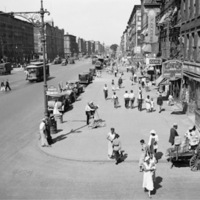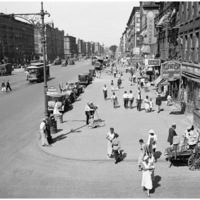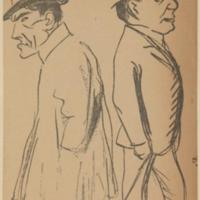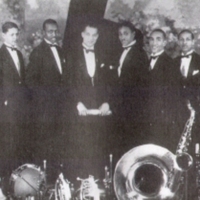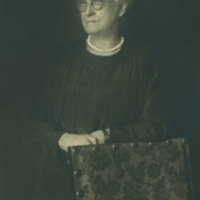1920s
Title
1920s
Subject
Sources and resources pertaining to the 1920s and literary works concerning this period.
Collection Items
Alberto Giacometti-- inspired by African Art?
Apparently a photograph from Life Magazine, showing Alberto Giacometti with a number of his sculptures. In form, they distinctly resemble the African art Alain Locke included in his article, "The Art of Our Ancestors," in the issue of Survey Graphic…
A Scene from Harlem in the 1920s
The exact location of this street scene in Harlem is unknown, however, it captures the energy, commerce and fashion in Harlem during the 1920s. As James Weldon Johnson described in The Making of Harlem, Harlem was a "self supporting community".…
Lenox Avenue: A Symbol of Hope
“We have to-morrow
Bright before us
Like a flame”
(663, Hughes)
This quote from one of Langston Hughes’ many poems expresses the hope that African Americans have during the time of the Harlem Renaissance. Hughes refers to this bright future as…
Bright before us
Like a flame”
(663, Hughes)
This quote from one of Langston Hughes’ many poems expresses the hope that African Americans have during the time of the Harlem Renaissance. Hughes refers to this bright future as…
Live Jazz
Jazz was a major part of the culture of 1920s. The newly available technology such as radio and phonographs allowed this type of music to be easily accessed by all groups. For one of the first times in history, it was easy for the general public to…
Harlem Nightlife Map
This map depicts the social nightlife of Harlem in the early 1930’s. It was drawn by E. Simms Campbell who was an African American artists in the 1900’s, who frequently had his work publish in African American magazines. The map shows specific night…
Lenox Avenue Clubs
Lenox Avenue was the most popular street in Harlem during the Harlem Renaissance. Lenox Avenue served as a major hub for African American culture during the Harlem Renaissance. Here, clubs and restaurants sprung up that featured some of the most…
Whites in the Cotton Club
"So thousands of whites came to Harlem night after night, thinking the Negroes loved to have them there, and firmly believing that al Harlemites left their houses at sundown to sing and dance in cabarets, because most of the whites saw nothing but…
Lenox Avenue
This photo is an picture of Lenox Avenue in the 1920s. Lenox Ave seems to be a predominately African American area and also very busy and bustling. Lenox Ave is filled with identical buildings, all of which have the same height, same width, and…
Dream A Little Dream Of Me
Louis Armstrong was an important figure in the development of jazz music. He influenced the jazz we know today as a pivotal trumpeter, singer and song writer. He was one of the first popular African-American entertainers. Starting with his trumpet…
Broadway Contrasts. George Beban and Holbrook Blinn.
Below is a image that is titled "Broadway Contrasts. George Beban and Holbrook Blinn." and it features two men back-to-back who were famous actors at the time. The man on the right is Holbrook Blinn who looks more business dressed with a rounded hat…
Labor Strike in 1920's
This image demonstrates a labor strike. The workers are upset with their low wages and poor working conditions. This image was taken during the Great Depression but it is described in the article that minority workers found little difference…
Laws for Granting Citizenship to Women
"Vos Yede Froy Darf Visen Vegen Birgershaft", which directly translates to "What Every Woman Should Know about Citizenship." The book is written in both Yiddish and English. This information booklet was made in 1926 by the National Council of Jewish…
Song of the Tower
It shows a Jazz player at the center of a very chaotic and apocalyptic setting. The reason it caught my eye is because it shows what is a seemly positive and powerful image in the middle of a dark place which can be correlated to its influence from…
Club Alabam
The picture shows a integrated night club during a time where this was very unpopular to do. It was mentioned in the poem "Little Cinderella" which is what drew my interest to it. You can see that it is a very lively place where both Black and White…
Cotton Club Orchestra
The photo featured here is the orchestra that played at the infamous Cotton Club in Harlem. As Langston Hughes mentioned in his reflective piece about Harlem Renaissance, the Cotton Club was a club exclusively for white patrons in the middle of…
PanelNo. 31
It is a mixture of the harsh broad colors of the street and environment met with much brighter and happier colors that were found in the shops and homes of those living in Harlem.
Wedding Party of Four
This photo depicts two young black couples dressed on what can be assumed their wedding day. James Van Der Zee, the photographer of this photo, was well known during the Harlem Renaissance. He documented the portraits of the African Americans that…
Charlotte Mason Osgood
This a photo of Charlotte Mason Osgood, the patron of African American Arts during the Harlem Renaissance. Ms.Osgood supported many famous Harlem Renaissance writers and artists like Langston Hughes and Zora Neale Hurston. Langston Hughes mentions…
The Crisis Magazine Cover
This is a cover of the Crisis magazine designed by Aaron Douglas, a famous artist during the Harlem Renaissance. The cover is very similar to his other work that is featured in Fire!!. Many geometric shapes are used to vaguely represent human arms.…
New York's Lower East Side
This painting by Albert Potter appeared very informative to me as it so vividly depicts New York's Lower East Side. During the beginning of twentieth century, the Lower East Side was essentially the main area where a large amount of Jewish…


